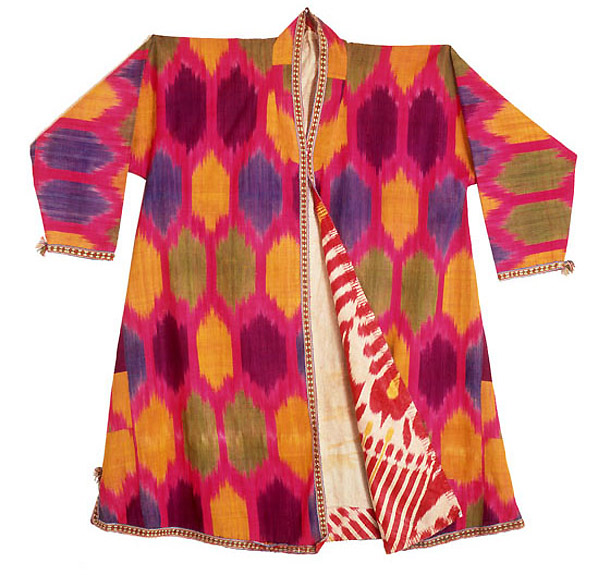Something I have come across and thought was very interesting was this woven robe which is a central Asian ikat. Ikat is an ancient technique in textiles ranging from Southeast Asia to South America to the Middle East etc. It is a process in which ‘loose threads are tied into bundles using grasses or wax-treated cotton to specify where the dye is able to sink in and colour the thread’ (Apartment Therapy, 2010), very similar to tie-dye techniques. It is an extremely difficult process to master, where the weaver then has to figure out which order the threads and dyes go, in order to create a pattern on the loom. This requires practice, patience and a lot of concentration. The more colours you add, the harder it is to create these exquisite, vibrant patterns.

‘Man’s robe with large spots on a bright pink background, Bukhara, Uzbekistan, about 1900. Silk and cotton, lined with cotton. From the Rau collection’ (figure 1)
It is to be believed that it all started in the 19th century. ‘Although produced in many parts of the world, 19th century ikats from Central Asia are unrivalled for their vibrant colours and bold designs’ (Ann Arbor, Mich), this shows that although the ikat weaving process was all over the world, Central Asia was most famous for it as their skills, fascinating patterns and daring designs were outstanding and eye-catching comparing with other countries. This made Central Asia very popular, ‘Central Asia experienced a period of economic and cultural growth, and the golden age of ikat making was closely bound up with this new dynamism. A new market for luxury ikat textiles emerged’ (V&A). This was when it really caught on and blossomed, becoming more and more common to see and being something everyone wanted and desired. It was a great way to show status and wealth, whether that be in clothing, such as robes, or for wall hangings in homes making great bohemian styled interior décor. ‘In the streets of Central Asian oasis towns, a man’s clothing defined his status in society and proclaimed his wealth. In the home and during family ceremonies, ikat textiles provided luxurious embellishment.’ (GW). Owning these beautiful woven fabrics was really something to be proud of and often shown off. Even today it is still very popular and is still seen in fashion and interiors worldwide.

‘Ikat wall hanging’ (figure 2)
‘The Central Asian ikat weaving process is thought to have begun in the city of Bukhara. The city of Bukhara had the most vital economy, the most active trade, and the greatest amount of surplus wealth’ (Salaam 2015), this all obviously helped with making it big and making Central Asia most famous for it. By having the money and the people, it really was a good head start to make Central Asia well known in history for this textiles tradition. ‘In Bukhara there were over 50 neighbourhoods involved in textile production of all kinds’ (Salaam 2015), textiles was a big part of their lives which they were all evidently passionate about.
There is so much more to the art of ikat then you think, it isn’t just a piece of fabric or item of clothing, each piece really has a meaning, ‘Every island, weaving village or family has its own patterns and colours that tells them their history. This makes every ikat special and unique.’ (Curms, 2015). This must be such an amazing culture to be a part of, the technique has so much depth and really tells a story. It is like a family heirloom, something to pass down for generations and generations.

‘Traditional ikat’ (figure 3)
Overall I think the process on a whole is incredible and skilful, from the preparation and technique to the end result. I love how there is meaning to the tribal designs and how the tradition has carried on and still continues to grow today.
Bibliography:
1-Apartment Therapy
The History of Ikat, By Anna Hoffman
Published 01/07/10
http://www.apartmenttherapy.com/warped-the-story-behind-ikat-r-105283
Viewed on 03/12/15
2-Ann Arbor, Mich, 1994
Newsletter, East Asian Art and Archaeology
P NO. 23
3-V&A
Central Asian ikats from the Rau collection
http://www.vam.ac.uk/content/articles/c/central-asian-ikats-from-the-rau-collection/
Viewed on 03/12/15
4-GW
Colors of the Oasis: Central Asian Ikats
https://museum.gwu.edu/colors-oasis-central-asian-ikats
Viewed on 06/12/15
5-Salaam
Art and Music, 2015
http://www.salaam.co.uk/themeofthemonth/july02_index.php?l=7
Viewed on 07/12/15
6-Curms
The ikat weaving process
2015
http://curms.com/ourstory/206-2/
Viewed on 10/12/15
Figure 1-V&A
Central Asian ikats from the Rau collection
‘Man’s robe with large spots on a bright pink background, Bukhara, Uzbekistan, about 1900. Silk and cotton, lined with cotton. From the Rau collection’
http://www.vam.ac.uk/content/articles/c/central-asian-ikats-from-the-rau-collection/
Viewed on 03/12/15
Figure 2-Funk Factory By Pavitra
‘Ikat wall hanging’, 2013
http://www.funkfactoryinteriors.com/blog/?currentPage=6
Viewed on 06/12/15
Figure 3-Curms
‘Traditional ikat’ 2015
http://curms.com/ourstory/206-2/
Viewed on 10/12/15